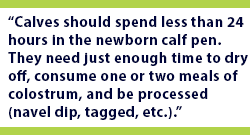
Calf Care Checklist: 8 Key Features of Newborn Calf Pens
 By Dr. Noah Litherland, Vita Plus dairy youngstock technical specialist
By Dr. Noah Litherland, Vita Plus dairy youngstock technical specialistCalf care during the first 24 hours after birth has a significant impact on calf performance during the nursery phase and beyond. Thermal support, hygienic environment and convenient to use are key attributes of a newborn calf pen. Examples of newborn calf pens include:
- Individual pens, such as 4-by-4-foot pens
- Group pen in a super hutch dedicated to newborn calves
- Group pen in a room dedicated to newborn calf housing
Here are eight key attributes of newborn calf pens:
1. Warm and draft-free.
The most important aspect of a newborn calf pen is to provide thermal support to prevent cold stress. In utero, the calf’s environment is 102 degrees F. Thus, calves typically experience a degree of cold stress after calving. Hypothermia occurs when a calf loses heat faster than it can produce heat, causing a dangerously low body temperature. Immersion hypothermia develops more quickly than standard hypothermia because fluids conduct heat away from the body 25 times faster than air.
Newborn calf pens can minimize cold stress by maintaining the calf body temperature in the thermal-neutral zone. Warmed calves are more vigorous, drink colostrum and milk more readily, and have greater potential to thrive in the early nursery phase than calves that are cold-stressed at birth. Furthermore, research suggests calves that are cold-stressed at birth have lower peaks in blood colostrum IgG, indicating decreased absorption efficiency of IgG or shifts in where IgG is positioned in the body, possibly indicating signs of stress.
Heat can be provided in the form of infrared heaters, forced-air furnaces, in-floor heat, or properly mounted and secured heat lamps. Insulate walls for efficient warming. Newborn calf pens should provide thermal support up to 70 degrees F for the first 24 hours and be draft-free. Drafts disrupt the insulating boundary layer around the calf, resulting in a cooling effect.
2. Provides insulation.
Many calf experts focus on the nesting properties of calf bedding, especially during the first 24 hours. Newborn calves benefit from the insulation provided by deep-bedded, long-stem straw, allowing them to nest with all limbs covered with straw. We suggest avoiding sawdust bedding in this phase as sawdust fines can be a respiratory irritant and sawdust does not provide the nesting benefits of long-stem straw.
 3. Appropriately sized.
3. Appropriately sized.
Newborn pens should be individual pens or house a maximum of four calves per pen. Calves should spend less than 24 hours in the newborn calf pen. They need just enough time to dry off, consume one or two meals of colostrum, and be processed (navel dip, tagged, etc.). Minimizing the number of calves in the pen and the time calves spend in the pen decreases the opportunity for pathogen load to bloom.
4. Multiple pens.
Consider establishing two or more newborn calf pens to allow for adequate capacity and prevent overcrowding. Multiple pens also allow for one pen to be cleaned and dried prior to repopulating.
5. Conveniently located.
Ideally, newborn calf pens should be located near maternity pens for increased convenience for maternity workers, but out of direct line of site of cows in the calving process. When designing a newborn calf pen, think about the processes of moving out of maternity, feeding colostrum and other tasks, including cleaning. Conveniently located windows for viewing newborn calves allows workers to frequently observe natural behaviors of newborn calves and spot problems early. Some farms have installed simple roll-down curtains.
6. Convenient to use.
Newborn pens should be designed to facilitate easy movement of calves in and out of maternity. Raised newborn calf pens might make it easier to feed calves, but it will be more difficult to move calves in and out of the pens. Sleds and carts are helpful in newborn transportation. If recording newborn weights, having a scale big enough to hold a cart while moving calves offers practical convenience. Provide adequate lighting for workers to see and adequate ceiling height for a comfortable working environment.
7. Communication.
Using a white board or a maternity data recording sheet to communicate colostrum feeding, navel dipping, and immunization is helpful to make sure each calf is systematically cared for and receives all planned steps in the newborn onboarding process. Simple collars with a number can help keep newborn calves properly identified before ear tags are applied. Number individual calf pens to make it easier to identify calves. Paint stick marks can help quickly identify which calves have received colostrum.
8. Hygiene.
Calving pen hygiene impacts both the cow and the calf. Cows naturally lick their calf following birth to stimulate the calf. The maternity bedding should be clean, dry and free of manure to prevent the cow from consuming manure when licking the calf. Additionally, hygienic calving pens also decrease the risk of fecal-oral pathogen transfer from cow to calf. Pathogens in the maternity pen will likely be transferred into the newborn calf pen on the calf’s exterior.
Design newborn calf pens to be easily cleaned after each calf by scraping straw, washing down panels (a drain and sloped floors are helpful), and foaming or disinfecting.
| Category: |
Animal health Bedding Facility design Starting Strong - Calf Care |

